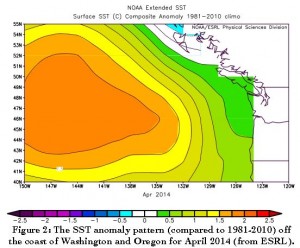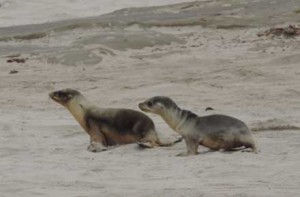9 April 2015
WASHINGTON, D.C. – The one common element in recent weather has been oddness. The West Coast has been warm and parched; the East Coast has been cold and snowed under. Fish are swimming into new waters and hungry seals are washing up on California beaches.
A long-lived patch of warm water off the West Coast, about 1 to 4 degrees Celsius (2 to 7 degrees Fahrenheit) above normal, is part of a larger pattern driven by the tropical Pacific that’s wreaking much of this mayhem, according to two recent papers in Geophysical Research Letters, a journal of the American Geophysical Union.
“In the fall of 2013 and early 2014 we started to notice a big, almost circular mass of water that just didn’t cool off as much as it usually did, so by spring of 2014 it was warmer than we had ever seen it for that time of year,” said Nick Bond, a climate scientist at the University of Washington-based Joint Institute for the Study of the Atmosphere and Ocean, and lead author of one of the new studies.

This figure shows how much warmer sea surface temperatures off the coast of Washington and Oregon were in April 2014 as compared to 1981-2010. New research finds that the long-lived patch of warm water off the West Coast, dubbed “the blob”, is part of what’s causing unusual weather on the East and West coasts.
Credit: NOAA
Bond coined the term “the blob” last June in his monthly newsletter as Washington’s state climatologist. He said the huge patch of water – 1,000 miles (1,609 kilometers) in each direction and 300 feet (91 meters) deep – had contributed to Washington’s mild 2014 winter and might signal a warmer summer.
Ten months later, the blob is still off our shores, now squished up against the coast and extending about 1,000 miles (1,609 kilometers) offshore from Mexico up through Alaska, with water about 2 degrees Celsius (3.6 degrees Fahrenheit) warmer than normal. Bond says all the models point to it continuing through the end of this year.
The new study by Bond and his colleagues explores the blob’s origins. It finds that it relates to a persistent high-pressure ridge that caused a calmer ocean during the past two winters, so less heat was lost to cold air above. The warmer temperatures we see now aren’t due to more heating, but less winter cooling.
The authors look at how the blob is affecting West Coast marine life. They find fish sightings in unusual places, supporting recent reports that West Coast marine ecosystems are suffering and the food web is being disrupted by warm, less nutrient-rich Pacific Ocean water.
The blob’s influence also extends inland to affect West Coast weather. As air passes over warmer water it picks up heat, resulting in a tendency for warmer temperatures and reduced mountain snow packs, which may be exacerbating current drought conditions along the West Coast.
The blob is just one element of a broader pattern in the Pacific Ocean whose influence reaches much further – possibly to include two bone-chilling winters in the Eastern U.S.
A separate study in GRL by Dennis Hartmann, a UW professor of atmospheric sciences, looks at the Pacific Ocean’s relationship to the cold 2013-14 winter in the central and eastern United States.
Despite all the talk about the “polar vortex,” Hartmann argues we need to look south to understand why so much cold air went shooting down into Chicago and Boston.

Two California sea lion pups, one fairly healthy, and one emaciated. Recent studies show a warm patch of water off the West Coast may be affecting marine life there.
Credit: NOAA
His study shows a decadal-scale pattern in the tropical Pacific Ocean linked with changes in the North Pacific, called the North Pacific mode, sent atmospheric waves snaking along the globe to bring warm and dry air to the West Coast and very cold, wet air to the central and eastern states.
“Lately this mode seems to have emerged as second to the El Niño Southern Oscillation in terms of driving the long-term variability, especially over North America,” Hartmann said.
In a blog post last month, Hartmann focused on the more recent winter of 2014-15 and argues that, once again, the root cause were surface temperatures in the tropical Pacific.
That pattern, which also causes the blob, seems to have become stronger since about 1980 and lately has elbowed out the Pacific Decadal Oscillation to become second only to El Niño in its influence on global weather patterns.
“It’s an interesting question if that’s just natural variability happening or if there’s something changing about how the Pacific Ocean decadal variability behaves,” Hartmann said. “I don’t think we know the answer. Maybe it will go away quickly and we won’t talk about it anymore, but if it persists for a third year, then we’ll know something really unusual is going on.”
Bond says that although the blob does not seem to be caused by climate change, it has many of the same effects for West Coast weather.
“This is a taste of what the ocean will be like in future decades,” Bond said. “It wasn’t caused by global warming, but it’s producing conditions that we think are going to be more common with global warming.”
NOTE: The 2nd and 9th paragraphs of this press release, highlighted in bold, have been updated for clarity. The original text is available here. These clarifications were made in collaboration with the University of Washington.
###
The American Geophysical Union is dedicated to advancing the Earth and space sciences for the benefit of humanity through its scholarly publications, conferences, and outreach programs. AGU is a not-for-profit, professional, scientific organization representing more than 60,000 members in 139 countries. Join the conversation onFacebook, Twitter, YouTube, and our other social media channels.
Notes for Journalists
Journalists and public information officers (PIOs) of educational and scientific institutions who have registered with AGU can download a PDF copy of these articles by clicking on these links:
Bond et al paper: http://onlinelibrary.wiley.com/doi/10.1002/2015GL063306/abstract?campaign=wlytk-41855.5282060185
Hartmann paper: http://onlinelibrary.wiley.com/doi/10.1002/2015GL063083/abstract?campaign=wlytk-41855.5282060185
Or, you may order a copy of the final paper by emailing your request to Nanci Bompey at [email protected]. Please provide your name, the name of your publication, and your phone number.
Neither the papers nor this press release is under embargo.
“Causes and Impacts of the 2014 Warm Anomaly in the NE Pacific”
Authors:
Nicholas A. Bond: Joint Institute for the Study of the Atmosphere and Ocean, University of Washington, USA;
Meghan F. Cronin: Pacific Marine Environmental Laboratory, NOAA, USA;
Howard Freeland: Fisheries and Oceans, Canada;
Nathan Mantua: Southwest Fisheries Science Center, NOAA, USA.
Title
“Pacific sea surface temperature and the winter of 2014”
Author:
Dennis Hartmann: Department of Atmospheric Sciences, University of Washington, Seattle, Washington, USA.
Contact Information for the Authors:
Nick Bond: [email protected], +1 (206) 526-6459
Dennis Hartmann: [email protected], +1 (206) 543-7460
Nanci Bompey
+1 (202) 777-7524
[email protected]
University of Washington Contact:
Hannah Hickey
+1 (206) 543-2580
[email protected]